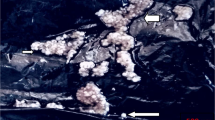Abstract
Pattern of arsenic bioaccumulation in six organ systems (blood, brain, gills, liver, muscles and skin) of Clarias batrachus was analysed following exposure to sublethal (1 mg L−1; 5 % of 96 h LC50 value) concentration of sodium arsenite. After 60 days of treatment the liver accumulated highest concentration (9.711 ± 0.138 μg g−1 dry wt of tissue.) of arsenic followed by gills (6.156 ± 0.154) > blood (6.070 ± 0.043) > muscles (5.756 ± 0.123) > skin (5.606 ± 0.140) > brain (2.350 ± 0.205). The bioaccumulations of arsenic in all the tissues were time dependant and increased with exposure period. Although the exposed fish loaded with arsenic did not die after prolonged treatment (60 days), the amount of arsenic accumulated made them unsuitable for human consumption. Due to depletion of the proteineous components of their muscles, the body mass of the exposed fish decreased without corresponding decrease in their length. This made the fish lean and thin. These proteineous moieties of the muscles and other tissue systems of the stressed fish were mobilized for breakdown to generate additional requirement of energy to combat the arsenic toxicity.


Similar content being viewed by others
References
Banerjee TK (1993) Estimation of acute toxicity of ammonium sulphate to the freshwater Catfish, Heteropneustes fossilis: analysis of LC50 values determined by various methods. Biomed Environ Sci 6:31–36
Banerjee TK (2007) Histopathology of respiratory organs of certain air-breathing fishes of India. Fish Physiol Biochem 33:441–454
Chen CJ, Hsueh YM, Tseng MP, Lin YC, Hsu LI, Chou WL, Chiou HY, Wang IH, Chou YL, Tseng CH, Liou SH (2001) Individual susceptibility to arseniasis. In: Chappell WR et al (eds) Arsenic exposure and health effects IV. Elsevier, Oxford, pp 135–143
Datta S, Saha DR, Chosh D, Majumdar T, Bhattacharya S, Majumdar S (2007) Sub-lethal concentration of arsenic interferes with the proliferation of hepatocytes and induces in vivo apoptosis in Clarias batrachus L. Comp Biochem Physiol Part C Toxicol Pharmacol 145:339–349
Fernandes D, Bebianno MJ, Porte C (2008) Hepatic levels of metal and metallothionins in two commercial fish species of the Nothern Iberian shelf. Sci Total Environ 271:1–9
Gilderhus PA (1966) Some effects of sublethal concentrations of sodium arsenite on bluegills and the aquatic environment. Trans Am Fish Soc 95:289
Kumar R, Banerjee TK (2012) Impact of sodium arsenite on certain biomolecules of nutritional importance of the edible components of the economically important catfish C. batrachus (L). Ecol Food Nutr 51:114–127
Larsson A, Haux C, Sjobeck ML (1985) Fish physiology and metal pollution: results and experiences from laboratory and field studies. Ecotoxicol Environ Saf 9:250–281
Maher W, Goessler W, Kirby J, Raber B (1999) Arsenic concentrations and speciation in the tissues and blood of sea mullet (Mugil cephalus) from lake Macquarie NSW, Australia. Mar Chem 68:169–182
Noel-Lambot F, Gerday C, Disteche A (1978) Distribution of Cd, Zn and Cu in liver and gills of the Eel, Anguilla anguilla with special reference to metallothionein. Comp Biochem Physiol Part C Toxicol Pharmacol 61:177–187
Palaniappan PLRM, Vijayasundaram V (2009) The bioaccumulation of arsenic and the efficacy of Meso-2, 3-dimercaptosuccinic acid in the selected organ tissues of Labeo rohita fingerlings using inductively coupled plasma-optical emission spectrometry. WASJ 6:1247–1254
Pandey PK, Yadav S, Nair S et al (2002) Arsenic contamination of the environment: a new perspective from central-east India. Environ Int 28:235–245
Pazhanisamy K, Vasanthy M, Indra N (2007) Bioaccumulation of arsenic in the fresh water fish Labeo rohita (Ham). Bioscan 2:67–69
Rodriguez VM, Carrizales L, Jimenez-Capdeville MK, Dufour L, Giordano M (2001) The effects of sodium arsenite exposure on behavioral parameters in the rat. Brain Res Bull 55:301–308
Sorenson EMB (1976) Toxicity and accumulation of arsenic in green sunfish, Lepomis cyanellus exposed to arsenate in water. Bull Environ Contam Toxicol 15:756
Wagner A, Boman J (2003) Biomonitoring of trace elements in muscle and liver tissue of freshwater fish. Spectrochim Acta B 58:2215–2226
Yang R, Yao T, Xu B, Jiang G, Xin X (2007) Accumulation features of organochlorine pesticides and heavy metals in fish from high mountain lakes and Lhasa River in the Tibetan Plateau. Environ Int 33:151–156
Acknowledgments
The senior author thanks the University Grant Commission Government of India for providing a Junior Research Fellowship. Thanks are also due to Dr. A. S. K Sinha Professor and Incharge Sophisticated Instruments laboratory, Department of Chemical Engineering and Technology, Institute of Technology, Banaras Hindu University, Varanasi for providing the Atomic absorption spectrophotometer facilities.
Author information
Authors and Affiliations
Corresponding authors
Rights and permissions
About this article
Cite this article
Kumar, R., Banerjee, T.K. Analysis of Arsenic Bioaccumulation in Different Organs of the Nutritionally Important Catfish, Clarias batrachus (L.) Exposed to the Trivalent Arsenic Salt, Sodium Arsenite. Bull Environ Contam Toxicol 89, 445–449 (2012). https://doi.org/10.1007/s00128-012-0714-8
Received:
Accepted:
Published:
Issue Date:
DOI: https://doi.org/10.1007/s00128-012-0714-8




